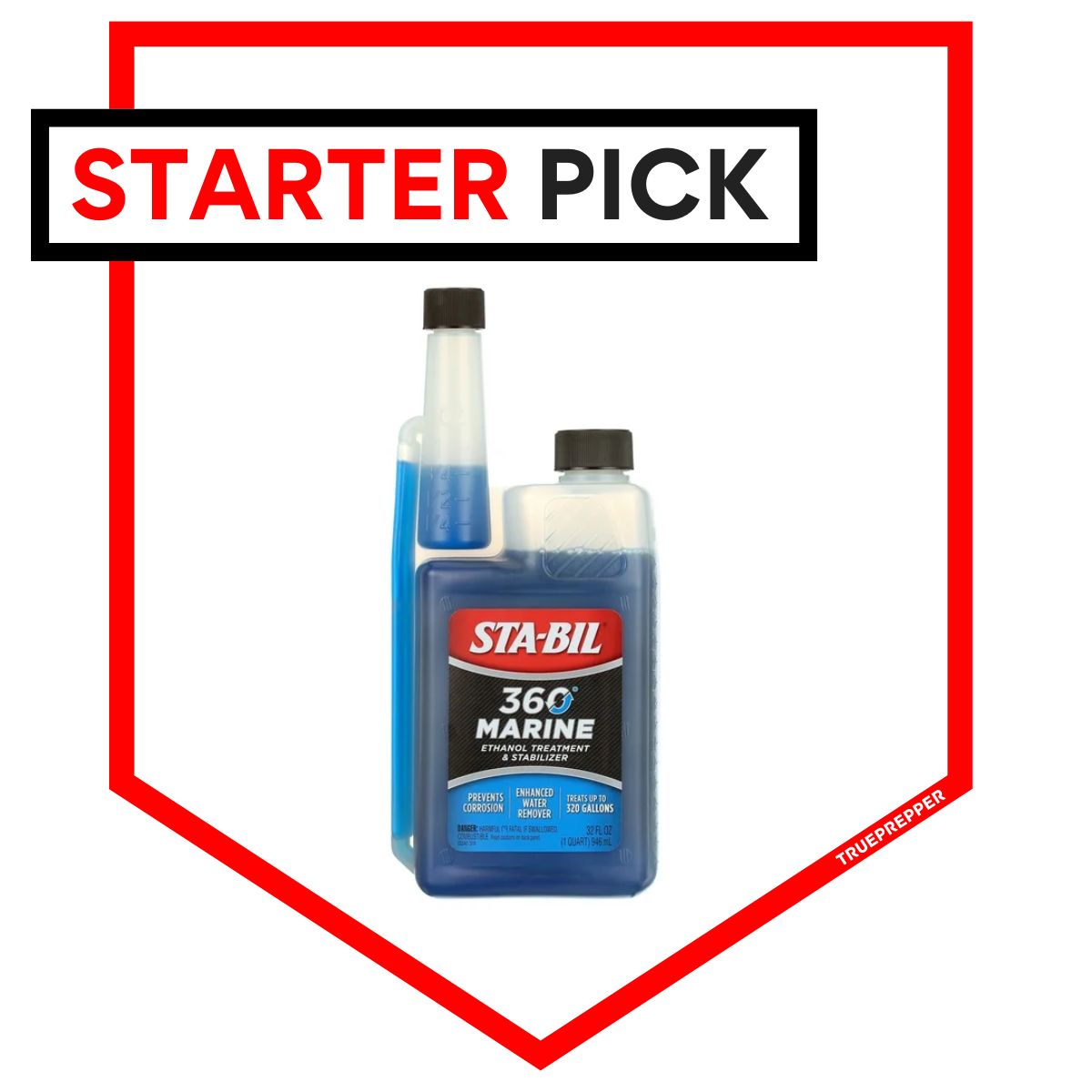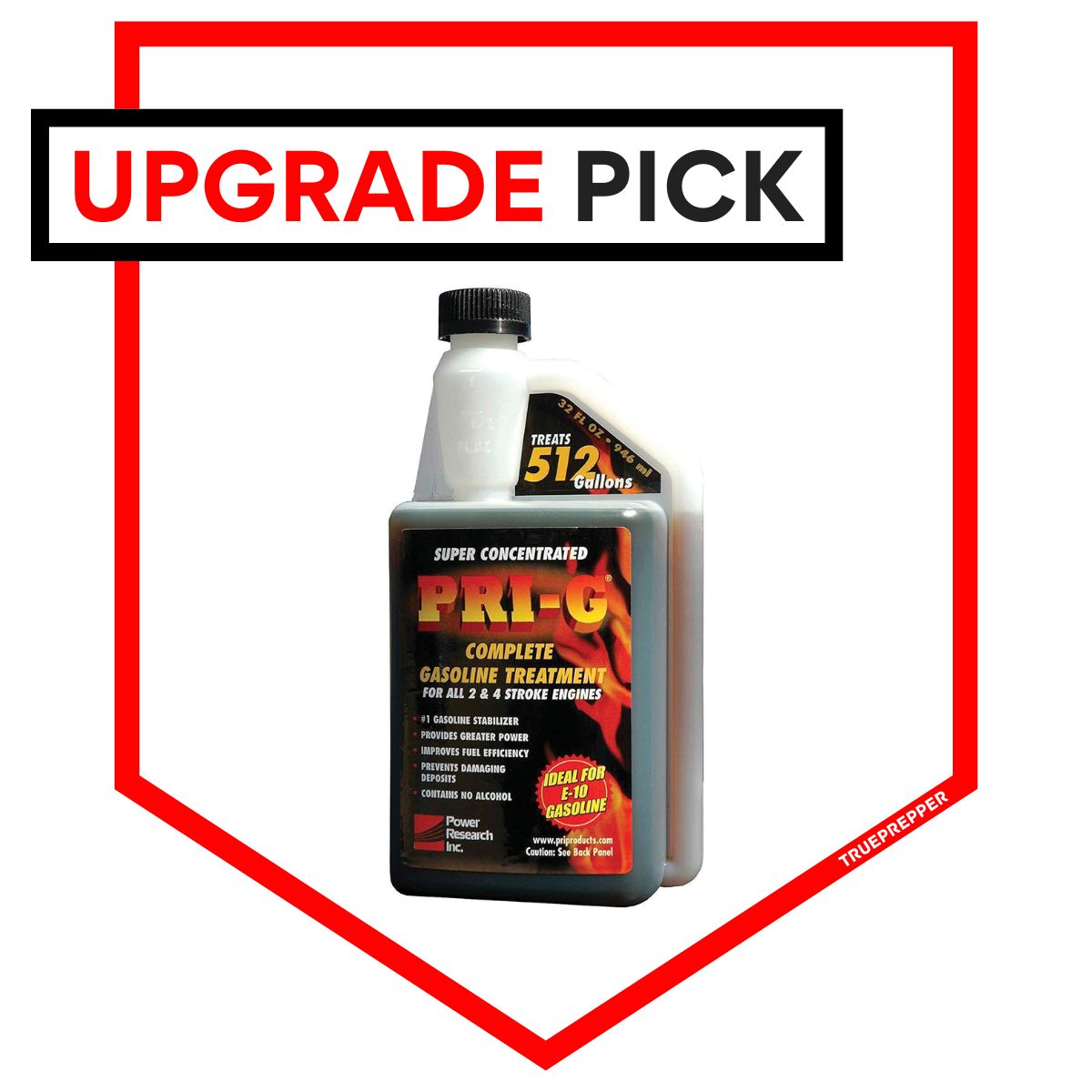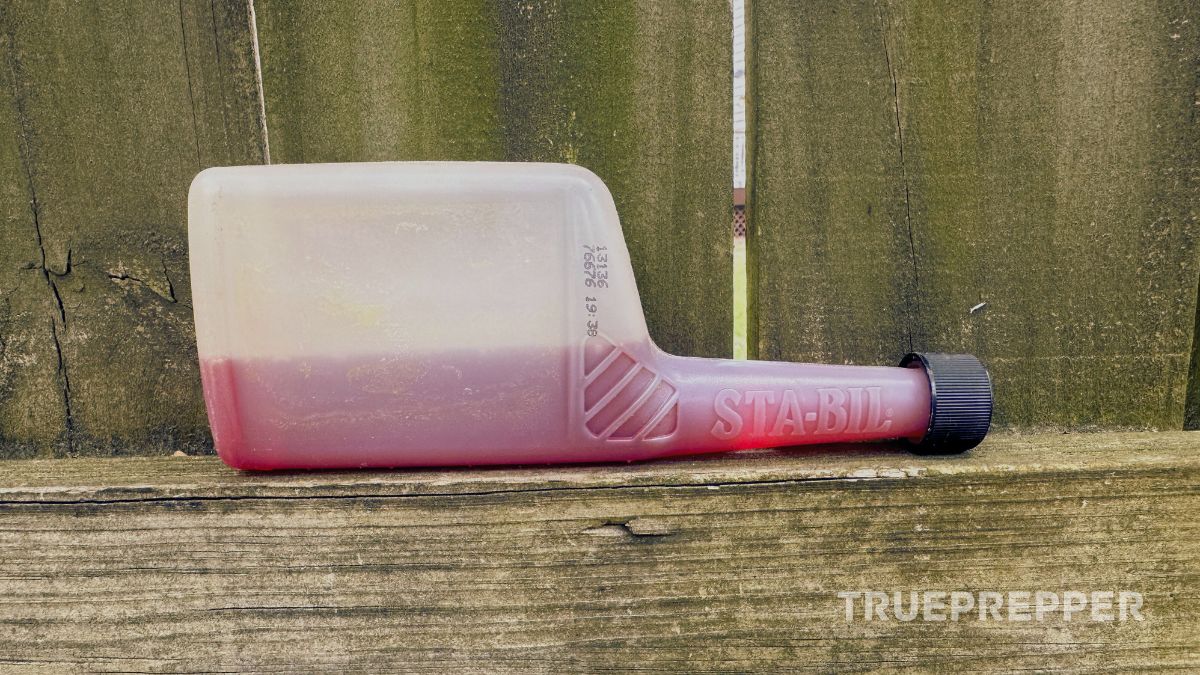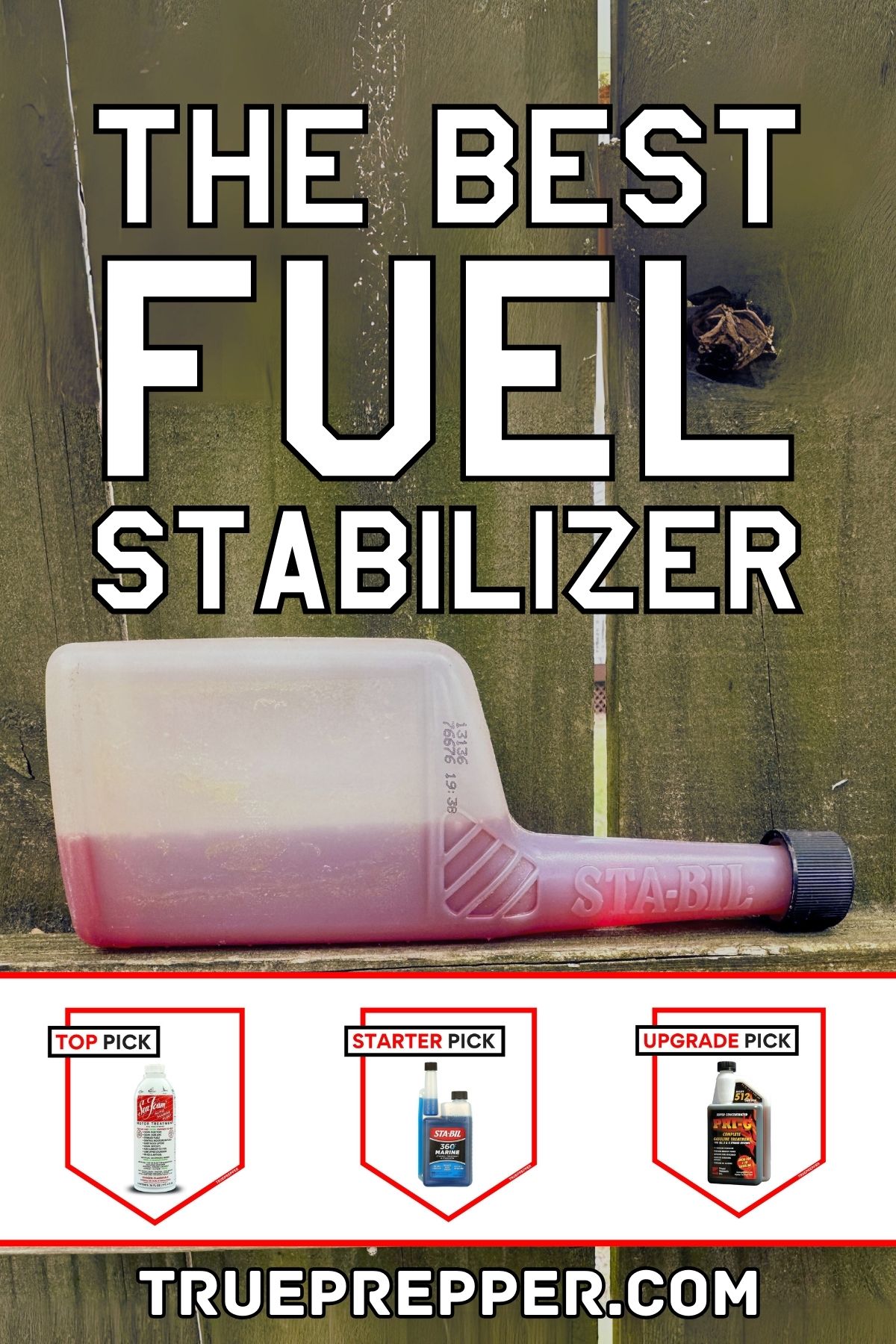Storing and stockpiling fuel is smart, but letting your gas go bad isn’t. Fuel stabilizer is proven to make a difference and the best fuel stabilizers prevent fuel from separating, gumming, and varnishing your engines. Keeping your gas refinery fresh is possible with optimal storage conditions and the right additive. There are many types and brands of fuel treatment out there with varying effectiveness.
This is where we come in. We’ve researched the best fuel stabilizers, compared them specifically for generators and gas storage, and now the results are in: the overall best, a budget option, and an upgrade option. If you need stable fuel, one of our picks will keep your stockpile in prime condition.
Contents (Jump to a Section)
The Best Fuel Stabilizer
Sea Foam
Effective, Versatile, and Reliable
Insanely versatile and trusted for a wide range of fuel types and applications.
*Price at time of publishing; check for price changes or sales.
Everyone recognizes the versatility of Sea Foam. Besides bringing stubborn engines back to life, one of its many talents is as a fuel stabilizer. Not only that, but it’ll help drastically improve the shelf life of nearly any type of fuel.
The one drawback is that it doesn’t treat a large number of gallons- if you are storing a serious amount of gasoline, you may want to jump down to our upgrade pick. But other than that, the versatility Sea Foam provides just can’t be matched and makes it ideal to have on hand for uncertain scenarios or just everyday use.
Here is what you get with the well-known wonder treatment:
- 16 oz can
- Treats 16 gallons
- Unlimited sealed shelf life (2 years after opening)
- 2-year added fuel shelf life
- 2 or 4-stroke gasoline, and diesel
Why it’s the best:
- Immensely versatile- use it to clean, lube, stabilize, and more.
- Easy to stockpile with unlimited shelf life.
- Works with almost every liquid fuel.
It’s reliable, effective, and crazy versatile- so it’s easy to see why Sea Foam Motor Treatment is the best.

Budget Fuel Stabilizer
STA-BIL Marine
Inexpensive, Effective, and Trusted
The big name in the game gets it done reliably and is the trusted budget option widely available.
*Price at time of publishing; check for price changes or sales.
STA-BIL has been treating fuel for a while and has a large suite of products. The ‘Marine’ fuel stabilizer is best for boats and everything else you want to keep water out of. Emergency generators and fuel storage fall into that category, and the blue stuff does a great job of removing water. The bottle keeps it simple and has an integrated measuring device to pour the right amount into your gas storage container.
People have been using STA-BIL for years across a wide range of industries and applications, so just because it’s cheap doesn’t mean it’s less effective. Our team swears by the blue Sta-Bil and it is well worth the couple of bucks it costs over the red Sta-Bil.
Here is how STA-BIL measures up:
- 32-ounce bottle
- Treats 320 gallons
- Unlimited sealed shelf life (2 years after opening)
- 2-year added fuel shelf life (1-year if ethanol fuel)
- 2 or 4-stroke gasoline
Why we like this for budgets:
- Cheapest per-ounce (but not necessarily treatment volume).
- Widely available online and at local stores, only slightly more expensive than Sta-Bil red.
- Removes water- the biggest enemy to your fuel storage and generator.
If you are looking for an inexpensive but trusted option, STA-BIL 360 Marine Fuel Stabilizer is what you need.

Upgrade Fuel Stabilizer
PRI-G Gasoline Treatment
Versatile, Protective, and Restorative
Improve power, fuel efficiency, and store fuel refinery-fresh for years on end with the best gas treatment available.
*Price at time of publishing; check for price changes or sales.
Less does more when it comes to Power Research Inc. (PRI) products. This bottle will treat a whopping 512 gallons, extending the storage life of a huge amount of gas. So, even though it bills as our most expensive suggestion- you can make it last and it’ll end up costing the least amount per gallon of gas treated.
PRI-G (made specifically for gasoline) is versatile enough to handle 2 and 4-stroke engines, but also ethanol gasoline if needed. It provides the maximum level of protection and reliability and is the best option to trust for emergency equipment.
Here are the full specs:
- 32-ounce bottle
- Treats 512 gallons
- Unlimited sealed shelf life (3 years after opening)
- 3-year added fuel shelf life (more with continued adding)
- 2 or 4-stroke gasoline
- Diesel treatment is also available: PRI-D
Why we like it for bulk fuel storage:
- It treats 16 times the fuel that our top pick does.
- Squeezing out what you need to add with the integrated measuring cup is easy.
- You can add unlimited shelf life by continuing to add this to your fuel every few years.
If you are looking for the best gas treatment available, grab PRI-G Gasoline Treatment.
Everything We Recommend
The Stabilizers We Compared
Our research narrowed the field down to several brands and types of stabilizers that we compared: STA-BIL, PRI, Yamaha, Star Brite, Seafoam, Quicksilver, Howes, Fuel Medics, Lucas, and more.
You can see our full list of review criteria below in the What to Look For section, with an explanation for each.
We considered a huge range of fuel treatments. We narrowed the focus to long-term storage and the use case for gasoline generators (from our previous gas generator review). We did rely on studies conducted by the government and military for long-term effectiveness since that can take half a decade to determine with fuel stabilizers. Those are listed in our sources and references.
We’re always looking for new and better solutions, so if you have some fuel stabilizer that you swear by, let us know in the comments. We review most of our tested supplies annually so we can try to get it in the next roundup round and see if it will beat out our top picks.
What to Look For
The best fuel stabilizer has a few features to look for:
- Value
- Solubility
- Shelf Life: Mixed
- Shelf Life: Unmixed
- Versatility
When you get the right blend of these, you can find a treatment that will consistently keep gas at premium quality. Below, we break down what each of these features means for the gas stabilizers that truly set themselves apart.
Value: Cost vs. Benefit
The amount of money you spend on something like a gas treatment shouldn’t blow out your entire budget. You’re likely balancing a budget between that, gas storage containers, gas itself, and gas-powered equipment.
You never want to spend too much money on one thing when it comes to preparedness. It’s better to diversify your supplies and budget to make sure you are covered for a wide range of scenarios.
Solubility
Fuel stabilizer should easily blend in with gas, even when you add it on top. Typically, it’s best practice to put fuel stabilizer in the container first, then add the gas to mix- but that isn’t possible when you are trying to further your gas storage shelf life by adding even more treatment.
The solubility of a fuel stabilizer is somewhat related to its viscosity, but that isn’t always a surefire indicator. You can typically tell how well the stabilizer blends with fuel by the amount you are allowed to add. If you can continue to add fuel stabilizer over the storage of the fuel, then it is usually more soluble than other treatments.
It’s also important that the stabilizer prevents ethanol fuel from separating as well if you end up storing that.
Shelf Life: Unmixed
The de-facto shelf life of fuel stabilizer in the container is unlimited, so any fuel stabilizer that isn’t hitting that is missing the mark. All of our suggested fuel treatments have limitless shelf life.
Shelf Life: Mixed
Once you add a fuel stabilizer to the fuel, results can vary. Typically we saw a 2-3 year shelf life extension of the gas in ideal conditions. However, a few options allowed for fuel additives to continue to be added through the storage life extending this virtually indefinitely.
As long as the stabilizer does not impact the effectiveness of the gas, this was typically the case. Our top pick and upgrade pick both can continue to be added to fuel storage for
Versatility
Some fuel treatments do a lot more than stabilize fuel. The versatility of a fuel treatment ended up being the difference between some of our placements. Being able to use it for a wide range of engine needs can help in any situation, but especially emergency ones you will probably encounter with your generator.

How to Use Fuel Stabilizer
Fuel stabilizer is easy to use, but the suggested amounts to add can vary widely between brands. The optimal mix ratios are listed on the packaging which usually makes it easy.
If you can, it usually is best to add the fuel stabilizer to your storage container or fuel tank before you add the gas. This way, pouring the gas will help agitate the mixture and blend the stabilizer more thoroughly.
With some types that isn’t necessary, as you can add stabilizer to the ‘top’ of the gas to further improve shelf life. Those treatments are very soluble and blend well even without agitation.
Arch does a great job of demonstrating fuel stabilizer and walks through our budget pick in a Champion 7500 generator:
Who Needs Fuel Stabilizer?
Fuel stabilizer is almost a necessity for anyone storing fuel. Most people who store fuel are those with small engine tools, or boats, or are doing it for preparedness. For those with generators, it’s probably a mix of these, as you are using it in the generator itself and/or your accompanying fuel storage.
Besides regular use in your garage, stabilizer can be considered for these survival kits:
With unlimited shelf life on all of our suggestions, it never hurts to have extra on hand either.
How We Review Products: We research thoroughly before selecting the best products to review. We have vast prepping and survival experience and bring in outside experts when needed. Hours on end are spent testing gear in stressful conditions and using specialized testing gear to verify claims. We assign performance criteria and impartially rate each tested item. Learn more about how we test.
Sources and References
All of our experience and the testing we do to determine the best fuel stabilizer are useless without listing our research sources and references. We leaned on these for the book knowledge that we paired with our hands-on testing and practical survival experience:
Frazier, R. (2009). Ethanol Gasoline Blends—Problems or Benefits for Customers? Energy Engineering. Volume 106. Issue 1. Pages 62-70. (Source)
Parker, G., et al. (2016). Two-Stroke Engine Cleanliness via a Fuel Additive. SAE Technical Paper. (Source)
Sluder, C., et al. (2022). Assessment of the Effectiveness of Three Aftermarket Gasoline Fuel Stabilizers in Preventing Gum Formation and Loss of Oxidation Stability. Oak Ridge National Lab. USDOE Office of Energy Efficiency and Renewable Energy (EERE). (Source)
The Final Word
Stabilizer is always needed for fuel storage, whether it’s for your generators or just your lawn tools. Using the best fuel stabilizer for your generators makes sense when you are relying on them for emergencies.
Here are a few other guides and reviews our subscribers have found helpful:
We presented quite a lot of information, but as always: if you have any questions let us know and we would be happy to help. Our research and testing found Sea Foam to be the best option given its value, solubility, shelf life, and versatility.
Keep exploring, stay prepared, and be safe.
You’ve Been Missing Out
Join the 2+ million preppers that rely on our prepping advice by subscribing to TruePrepper.
- Practical guides and tips
- Useful survival giveaways
- Free, forever
- < 0.4% of people unsubscribe

Read the full article here
